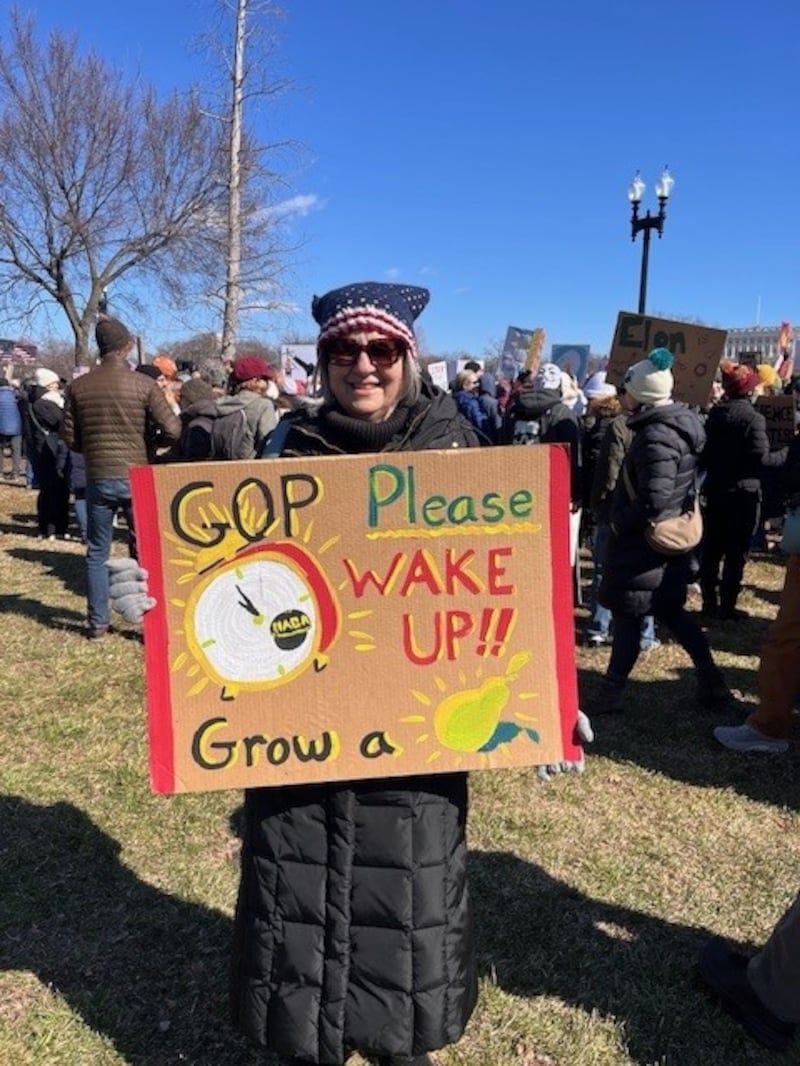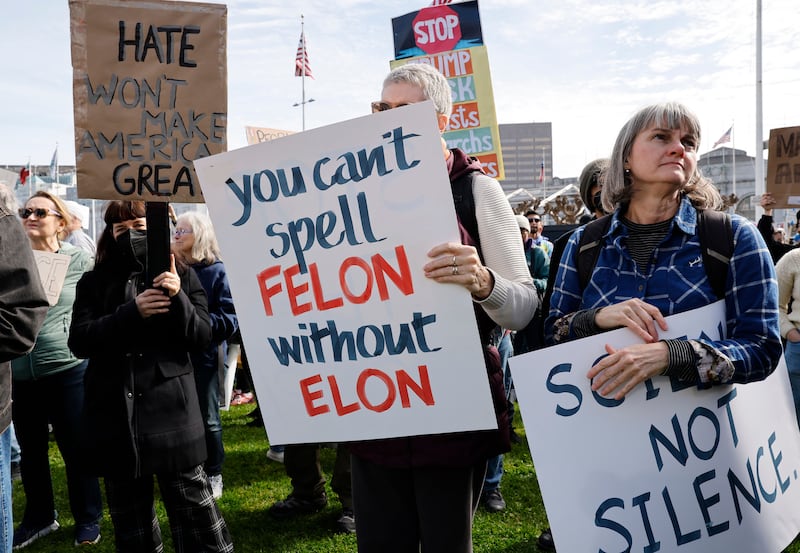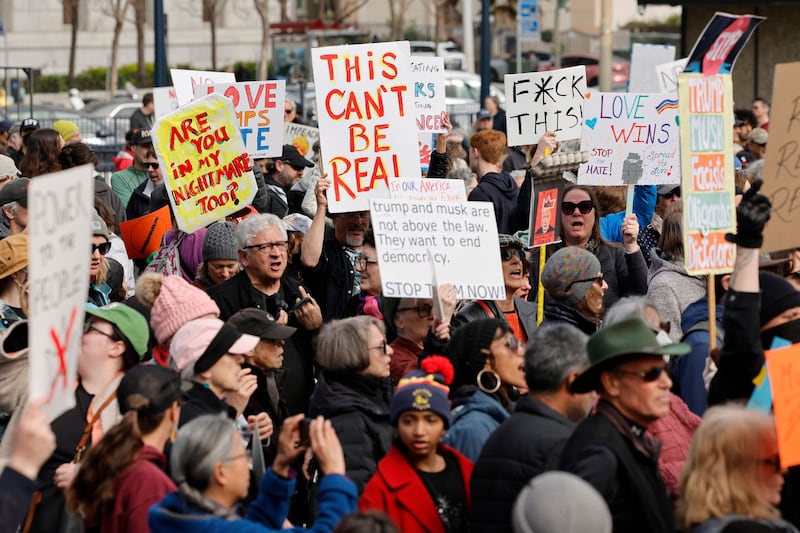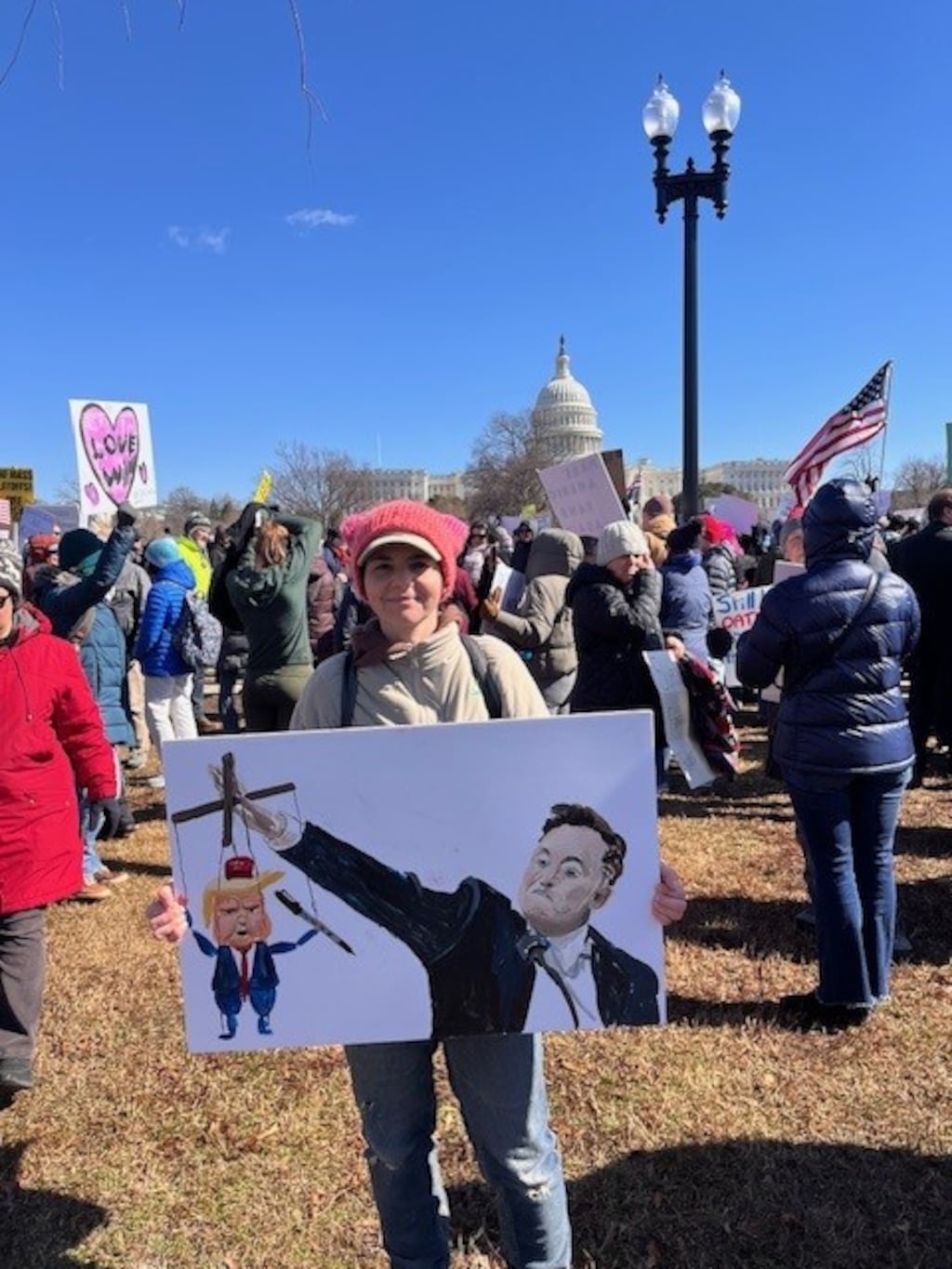Daryl Anderson left his home in West Virginia on a sparkling dawn morning for a five-and-a-half-hour drive to Washington. He had already prepared his protest sign: Trump/Satan on one side and, on the reverse, a stark question: ‘Is this 1935 or 2025?’
It was eye-catching, even through the display of hundreds of other signs held aloft by protesters who gathered at the Reflecting Pool, in front of the Capitol building.
Monday was Presidents’ Day in the United States. Similar protests were planned in front of state capitol buildings across the country, organised by the grassroots 50/50/1 movement. But Anderson presumed that given his home state voted 70 per cent for Donald Trump, there would be few protesters in front of the Charleston building. So, he headed for Washington.
“I never in my wildest imagination would have believed it would get to this. It is crazy. Absolutely crazy. My Dad was in World War Two, He was fighting Nazis in Czechoslovakia. And it just feels kinda like things I read about then; all the messaging, all the propaganda. The Trump-Satan part is that so many evangelical Christians voted for Trump and I am just saying I want them to think about it. Because they really voted for someone totally against their values.”
Several thousand people showed up. Across the country, the reported numbers varied: 1,000 on Boston Common; a few dozen in Colorado. Washington drew the biggest crowd on a sunny deep-freeze of a February day, and although everybody had gathered at noon, there was a sense of uncertainty over what to do next. A small choral group sang a rendition of the Star Spangled Banner. Chants of “Where is Congress? Do! Your! Job!” were orchestrated. Someone gave a speech but it sounded muffled and distant.
It was the imagination and art work of the signs that stood out. Teal Quinn showed up with a portrait of Elon Musk holding a loft a marionette version of a miniature Donald Trump. As we spoke, several people asked if they could photograph it.
“It could be the beginning of the end,” she said when asked about the symbolism of her sign.

“I’ve got kids. I’m worried about the planet, their rights. I’m worried about the CDC [Centres for Disease Control] and the NIH [National Institute of Health] and the Board of Ed. They are f**king everything up just to get more money into the pockets of the billionaires. I expected it to be bad but this is faster than I thought.
“But leading up to the election I said to all my friends, Project 2025 is going to happen. I had family say, no, no. The president doesn’t change much that fast. But I said he has already told us what he is going to do – and he did.”
Elsewhere in the crowd, Patricia Jacobs carried a sign challenging members of the Grand Old Party to find their voices.
[ Republic’s almost €73bn exposure to Donald Trump’s tariffsOpens in new window ]
“The Republicans are the politicians who can make a difference. Just a few people who are willing to be statesmen instead of politicians,” she said before nodding emphatically when asked if she believes that there are Republican representatives on Capitol Hill who may have private misgivings about the tone of the first month of the new administration.
“Absolutely. I think they do, and I think they feel afraid for their jobs. I’ve heard they feel afraid for their families, which is terribly frightening as a thought. I’m not sure why they are as pliant as they are. I feel there are things we will learn later that we don’t know now.
“But giving in and giving up is what I feel like they are doing. It’s ... incredible that they are silent. People that call themselves Reagan Republicans. I don’t know. I don’t want to judge them and say they are all about money or influence or pure ambition. But that’s what it looks like from here.”

The signs and banners held aloft against the backdrop of the Capitol building reflected the arguments and warnings voiced by the Democratic half of the country since inauguration day. They depicted Trump as a monarch, or protested Elon Musk’s gargantuan influence over the administration, or protested the mass federal lay-offs.
“An autocracy,” said Catherine, a former federal worker who lives in Maryland – she retired last year – when asked where she thinks the new administration is heading.
[ Lawyers resign rather than bend before TrumpOpens in new window ]
“It is their theory of absolute executive power. I think Trump said it well when he said, I can do anything in defence of the country. They are killing the checks and balances within the executive. I am hoping the judiciary can rise to the challenge but the system is slow. I’m afraid that we are starting in the steps of Hitler’s Germany where the leadership is creating lots of law – all of which is unlawful at the moment. Right now, we have to rely on the courts.”
The countrywide protests reflected not just the extreme divergence of opinion about the direction that the Trump administration is taking the United States but also the curious drift of the Democratic movement.
Trump is enjoying the best polling numbers of his political life and through its surface messaging, at least, the Republican Party is buoyant and united.
In contrast, Monday’s citizen protests coincided with the dismal findings for Democrats of the most recent Quinnipiac University poll, which showed that just 31 per cent of voters hold a favourable opinion of the defeated party – their worst return in the history of that particular poll. The lingering internal resentments caused by the dramatic candidate switch last summer has given way to a diverging views as to how the Democrats should rebuild.
“Best case scenario – there are three special elections, two in Florida, one in New York. Small chance we could get the House back,” said Quinn.
“But I think a general strike might be our last recourse.”

Others hope that these peaceful protests will become more frequent – as well as larger, and louder.
Patricia Jacobs doesn’t think that the current Democratic Party mode of opposition – zoom calls and demonstrations has made any tangible difference. Their first big decision will come when it is time to decide how to respond to the government funding deadline of March 14th.
Whatever happens, the Democratic recovery will be slow. Jacobs paused before answering whether she has any doubts that there will be a presidential election in 2028. “I am concerned. I don’t think it is a given. I think the supreme court giving Donald Trump immunity from anything he wants to do means he may think up some really crazy stuff.”






















